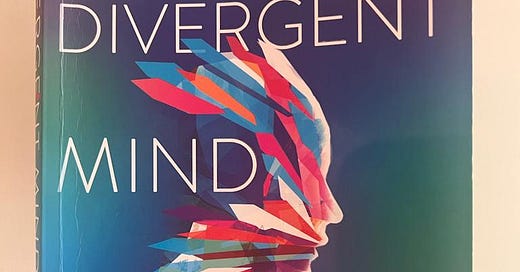Does "Diversity" Need An Update?
The case for considering high sensitivity alongside more established categories such as race, culture, and gender.
“I think our natural role as those in the minority, at the fringe, is to be the mirror to society. We’re big thinkers and creators, and we serve through our innovations and works of aesthetic beauty.” — Jenara Nerenberg, author of Divergent Mind.
HSP retreat update: Jules De Vitto and I would love to welcome you to the retreat we’re hosting at the amazing Quadrangle in Kent, UK from June 15-18. We’re very excited to be convening an in-person gathering, and have some very special guests for what’s shaping up to be a fantastic few days. For more details, please click here:
After decades of work by social activists, most organisations now acknowledge the importance of cultivating diversity and inclusion — particularly in terms of categories such as race, culture, sexual expression, and gender.
The benefits are clear: Just as a rich variety of plant and animal life helps a forest to stay healthy, groups that welcome people with a wide range of backgrounds and life experiences will be more innovative, flexible and resilient than those that don’t.
But what if — despite this progress — we’re still missing a key part of the puzzle?
I believe it’s time to expand our concept of diversity and inclusion to include our inner traits — especially high sensitivity.
Because an organisation may appear to be diverse on existing measures. But if everyone thinks, feels and acts the same, then it will never reach its full potential.
Learning To Thrive
A growing body of research shows that the way we process thoughts, emotions and sensory input varies enormously — including among Highly Sensitive People (HSPs). That’s partly why we may respond so differently to the same situation, or set of challenges. By acknowledging and valuing these differences, an organisation can avoid becoming the kind of intellectual monocultures that breed mediocrity, group-think and conformity — and tap into the dazzling power of human creativity at its best.
HSPs have enormous contributions to make via our empathy, intuition and capacity to understand complex systems. These are precisely the skills we need to face the interlocking global crises we face.
Nevertheless, this expanded vision of diversity raises a few immediate questions: How could organisations measure diversity in terms of personality traits — including the prevalence of HSPs? What might be the possible disadvantages or unintended consequences of creating another category for companies to consider? Is it even desirable for employers to take such a close interest in the inner lives of their employees? In a world of exponential advances in artificial intelligence, shouldn’t we seek to keep such intimate aspects of ourselves from the reach of the machines?
I don’t yet have answers to these and many more questions. I’m certainly not advocating for more top-down, tick-box diversity exercises. Neither am I suggesting the battle for diversity and inclusion by even our existing measures is won — far from it. But I do hope that diversity of temperament will start to be acknowledged organically as mainstream awareness of the gifts associated with high sensitivity starts to grow. The fact that the Financial Times and Wall Street Journal both reviewed the new book Sensitive: The Power of A Thoughtful Mind in an Overwhelming World by Jenn Granneman and Andre Sólo seemed to me to indicate a seismic shift is already underway. (For The HSP Revolution’s take on the book, click here).
And I’ve been encouraged to hear others in the sensitivity field making a similar case.
“Integral Aspects”
Professor Corina Greven, a leading sensitivity researcher in the Netherlands, concluded her inaugural lecture in June last year by arguing that we should expand our concept of diversity and inclusion to include high sensitivity — as well as distinct types of inner traits such as autism, or attention deficit hyperactivity disorder (ADHD).
“ADHD, autism and HSP should be considered integral aspects of diversity and inclusion,” Corina told her audience at the Radboud University in the Netherlands, where she leads a pioneering sensitivity research department.
(According to Dr Elaine Aron, the American psychologist who coined the term HSP, high sensitivity is a normal personality trait found in 20-30 percent of the population, whereas ADHD and autism are medical diagnoses, and considered disorders. Dr Aron has written a helpful blog on her understanding of the difference between high sensitivity and ADHD here. Corina and other sensitivity researchers are currently working to gain a clearer understanding of how high sensitivity may overlap with these traits and other aspects of neurodiversity).
Divergent Mind
In her speech, Corina referenced the work of Jenara Nerenberg, whose book Divergent Mind: Thriving In A World That Wasn’t Designed For You, I’ve been devouring over the past week.
Nerenberg’s path to writing this book began when she was feeling depressed and anxious after struggling to hold down demanding jobs — despite her obvious talents. She began to learn more about how neurodiversity affects women, and much of what she read resonated with her experiences.
I highly recommend this book for anyone — particularly women — seeking to understand more about high sensitivity; ADHD; autism; sensory processing disorder; dyslexia; misphonia and more. The book’s combination of moving case studies and accounts of scientific research make a strong case for how society has pathologised neurodiversity — forcing many women to suppress themselves to meet the demands of a one-size-fits-all society. Instead, Nerenberg says we should be celebrating the many amazing talents that high sensitivity and neurodivergence bring.1
“Being able to finally give a name to an experience is incredibly healing and liberating,” Nerenberg writes. “Once these women realize who they are, and once the world embraces what makes them unique, perhaps we’ll finally be able to utilize their strengths — because it’s not just about alleviating suffering, but the opportunity to improve our society as a whole.”
Let’s hope that — as awareness of high sensitivity grows — we’ll find that more and more organisations learn to support HSPs, and all others who diverge from the norm, to shine.
See you next week!
I warmly welcome you to join The HSP Revolution online membership community — where I host two live workshops per month, post daily inspiration, and provide opportunities to share and connect. Members also gain full access to four editions of this newsletter per month. See you there!
People have different ideas around whether high sensitivity should be classified as a form of neurodivergence. That’s a discussion outside the topic of this edition of The HSP Revolution.







Excellent point Dr. Genevieve! I've been thinking similarly for some years. The metrics of diversity (and the allocation of grants) can be quite surface level, superficial.
It's becoming more and more essential to think about ontological diversity as a key, if not *the* key element of diversity. Race/gender may be a marker of ontological diversity (diversity in ways of being, knowing, qualities of experience sensitivity) but it is not always. It is to the advantage of status quo orgs & corporations to adopt people who look different into the same structures, ontologies, ways of thinking and networks. We get a politics and news media that looks more diverse but is culturally the same club.